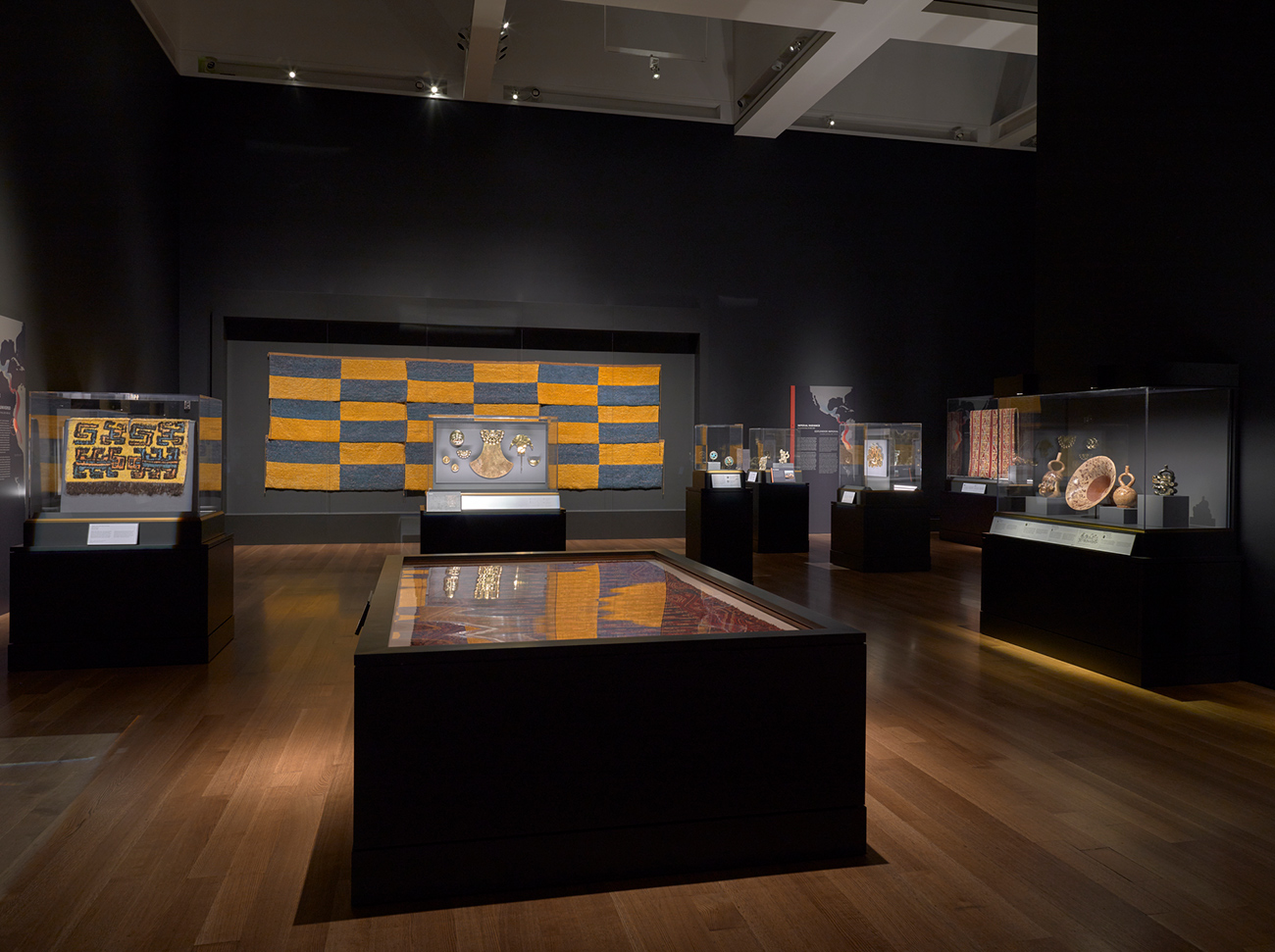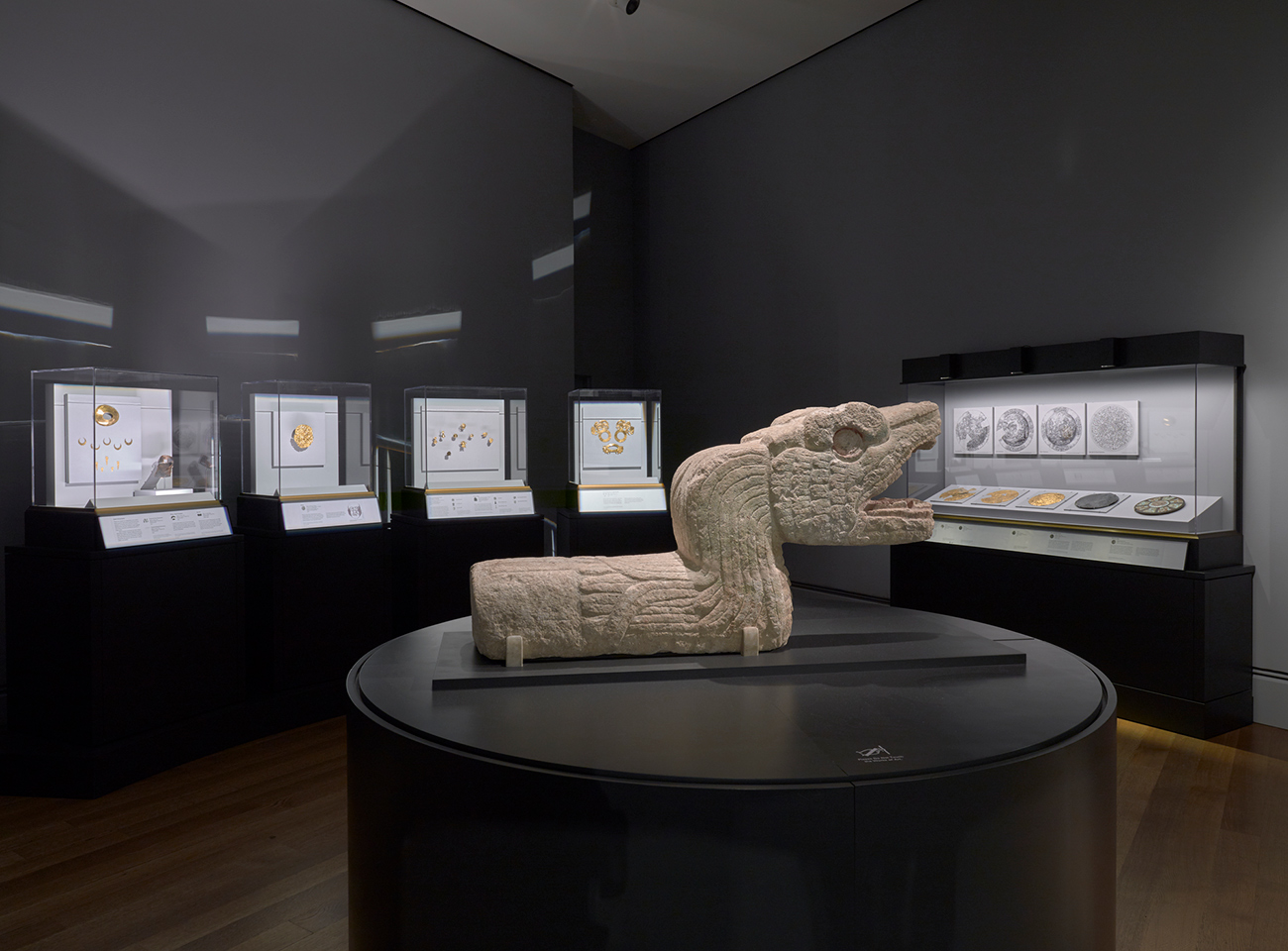
Title wall of Golden Kingdoms at the Getty Center. Photos here and below (except gallery plan): Rebecca Vera-Martinez
An art history graduate student at the University of Utah, Leah Carlson-Downie recently visited the exhibition Golden Kingdoms: Luxury and Legacy in the Ancient Americas and was inspired to summarize her impressions. It comes to us via her professor Elena Shtromberg, co-curator of another Pacific Standard Time exhibition, Video Art in Latin America, and co-editor of the accompanying catalogue. Lea esta publicación en español. —Ed.
The Pacific Standard Time: LA/LA initiative, officially running from September 2017 to January 2018, has resulted in a truly overwhelming proliferation of exhibitions featuring art from Latin America and Latino communities. Over 70 shows are now on view, presenting the public with a dizzying array of both artistic and curatorial perspectives on the subject of “Latin American art.”
While a wide variety of arts and cultural institutions organized shows for PST: LA/LA, the Getty is the initiative’s leader and source of funding. Golden Kingdoms: Luxury and Legacy in the Ancient Americas (on view at the Getty Center from September 16, 2017 to January 28, 2018) is the blockbuster exhibition that stakes the Getty’s claim as the epicenter of PST: LA/LA.
An Entry Point for PST: LA/LA
If you’re interested in experiencing PST: LA/LA but have no idea where to start, Golden Kingdoms offers a fascinating entry point. The exhibition, co-curated by Kim N. Richter from the Getty Research Institute and Joanne Pillsbury from the Metropolitan Museum of Art, comprises over 300 works from 53 lenders in twelve countries—making Golden Kingdoms one of the most ambitious shows of PST: LA/LA from an international cooperation standpoint.
Also ambitious is the temporal and geographical scope of the show, which spans approximately 2,500 years and several countries, stretching from the Andean region to Mesoamerica. Despite the broad sweep of the exhibition, Golden Kingdoms presents visitors with a cohesive yet challenging vision of the development of luxury arts in the ancient Americas; the show follows the spread of gold and metalworking technologies from the Andes to Mexico, but the exhibition emphasizes the idea that unlike later European conquerors, the ancient Americans themselves did not always consider gold the most valuable material.
Golden Kingdoms is the only show in the greater Los Angeles area that focuses on pre-Columbian art, which positions it as the natural starting point for those inclined to travel through the history of art (or the offerings of PST: LA/LA) chronologically. In this way, Golden Kingdoms could logically be framed as a fundamental exhibition of the PST: LA/LA initiative. Certainly, the design of the exhibition space envisions a chronologically minded visitor. The show begins with the earliest works, excavated in Peru, and ends with the latest pieces, from early sixteenth-century Mexico.
A Visit to the Galleries
The galleries are arranged in such a way that the visitor must follow a proscribed path through the exhibition. The framing narrative of the show—the northward spread of gold and metalworking—is physically and spatially imposed upon the visitor. Considering the scope of the exhibition, this may be necessary to help visitors make sense of what they are seeing. Each gallery displays work from a single region or culture; for example, the first gallery is dedicated to the Andean region, while the last two galleries show Mayan and Aztec arts, respectively.

Gallery plan of Golden Kingdoms at the Getty Center.
The clearly demarcated, separate gallery spaces, as well as maps on the gallery walls, keep visitors oriented geographically. The unidirectional flow through the exhibition also gives visitors a sense of progression through time. In this sense, the exhibition is evidently geared towards non-expert visitors. The curators do not expect visitors to have a pre-established narrative or timeline in their heads, and instead take care to provide a conventionally accepted conceptual structure within the exhibition.
The cost and effort expended to bring over 300 objects to the Getty on loan attest to the fact that Golden Kingdoms was conceived of as a major attraction exhibition. Indeed, Golden Kingdoms is scheduled to travel to the Metropolitan Museum of Art this spring. As such, the curators must straddle a fine line between delivering what audiences expect from a show of pre-Columbian luxury arts and suggesting alternative frameworks for viewing well-known objects.
While the organizing narrative and the title of the show emphasize gold, and therefore support well-established tropes of ancient American art, the objects included in the exhibition and the didactics that accompany them provide a counter-narrative. The promise of gold and silver famously lured Europeans across the Atlantic, but evidence suggests that the ancient Americans themselves were more ambivalent about gold. While gold was surely a valuable material, the curators of Golden Kingdoms suggest that materials such as feathers, textiles, shells, and jade were just as, if not more, valuable to ancient Americans at various points in history.
Arguably, the most arresting objects on display are not, in fact, made of gold. A beautiful, vibrantly red textile laid out horizontally in a vitrine dominates the first gallery. Behind this textile, a few yards back, an enormous blue and yellow checker-patterned example of feather work covers the entire wall. The “Forests of Jade” section highlights Olmec and Mayan masterpieces of jade work, and the didactics mention that drilling a hole into one piece of jade by hand could take up to 80 hours of labor.

Installation view of the first gallery of Golden Kingdoms, “For Gods and Kings,” looking into the second gallery, “Masters of the Universe.” Artwork in glass case at left: Tabard with Lizard-like Creatures, 400–700, Unknown artist, made in South Coast, Peru, South America Feathers on cotton. Virginia Museum of Fine Arts, Richmond, Arthur and Margaret Glasgow Fund. © Virginia Museum of Fine Arts. Artwork on the back wall: Feathered Panels, 600–900, Wari culture. Feathers on cotton, camelid fiber. The Metropolitan Museum of Art, New York, The Michael C. Rockefeller Memorial Collection, Bequest of Nelson A. Rockefeller, 1979 (1979.206.467).

Installation view of the “Lands Between the Seas” gallery of Golden Kingdoms. Case at left features pendants and plaques from the Peabody Museum of Archaeology and Ethnology, Harvard University; case at center features a vessel from the Museo Nacional de Costa Rica, San José, Costa Rica; case at right features objects from Museo Del Oro, Banco de la República

Installation view of the fifth gallery of Golden Kingdoms, “The Sacred Cenote at Chichen Itza.” Feathered Serpent, Maya, AD 800-1250, Museo de Sitio de Chichén Itzá, Secretaría de Cultura – INAH

Installation view of the seventh gallery of Golden Kingdoms, “Bright Kingdoms.” Sculptures at left: Female Figure, 1200–1521, unknown artist, made in Veracruz, Mexico. Limestone. Secretaría de Cultura – Instituto Nacional de Antropología e Historia. Museo de Antropología de Xalapa; Male Figure, 1200–1521, unknown artist, made in Veracruz, Mexico. Sandstone. Secretaría de Cultura – Instituto Nacional de Antropología e Historia. Museo de Antropología de Xalapa. Manuscript: Codex Mendoza, early 1540s, attributed to Francisco Gualpuyoguacal, illustrator, and Juan González, author. Pigment on paper. The Bodleian Libraries, University of Oxford, MS. Arch. Selden. A. 1, fols. 45v–46r
Displaying masterworks and well-known objects, both golden and not, in new contexts and combinations asks visitors to reconsider how they think about the value of each material. Rethinking or challenging accepted narratives surrounding Latin America is also fundamental to the PST: LA/LA project.
Whether conceived this way or not, Golden Kingdoms works as an interesting point of entry in to the web of PST: LA/LA. The exhibition works as both a flashy blockbuster show aimed at non-expert visitors as well as a scholarly re-consideration of the pride of place gold inhabits in the imagined ancient Americas of the Euro-American mind. In some ways, the stated goal of the entire initiative is just that: to show the public works that they have never seen before, while also, according to the initiative’s website, raising “complex and provocative issues about present-day relations throughout the Americas.” In the case of Golden Kingdoms, maybe the beginning is the best place to start.

INAH artworks are reproduced courtesy of Secretaría de Cultura – Instituto Nacional de Antropología e Historia
Text of this post © Leah Carlson. All rights reserved.




Comments on this post are now closed.